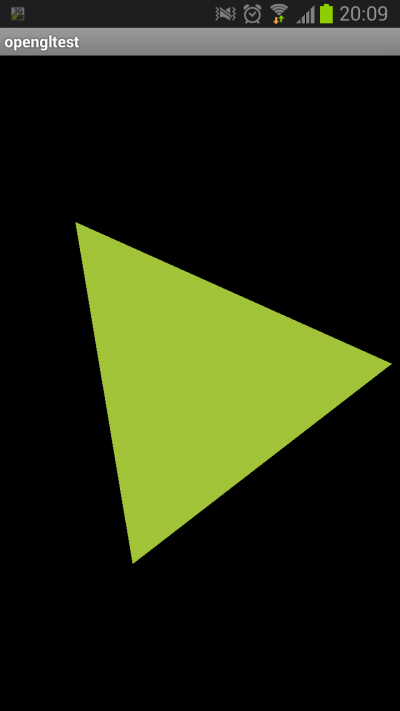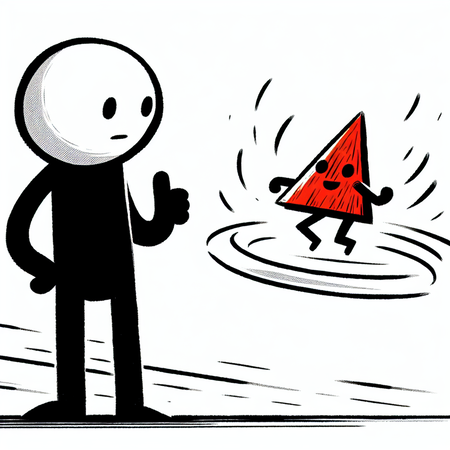The last days i fiddled a bit with OpenGL 2 on Android. The Android OpenGL tutorials are a bit outdated, so i had to do some API research by myself and copy and merge the provided examples together. Here is a screenshot of the running OpenGL App:

It supports touch events to rotate a triangle around and render the animation.
To run OpenGL, we need the base Activity class as follows:
package com.example.opengltest;
import android.app.Activity;
import android.os.Bundle;
public class OpenGLTestActivity extends Activity {
private MyGLSurfaceView glSurfaceView;
@Override
public void onCreate(Bundle savedInstanceState) {
super.onCreate(savedInstanceState);
glSurfaceView = new MyGLSurfaceView(this);
setContentView(glSurfaceView);
}
}Then we need the OpenGL view class:
package com.example.opengltest;
import android.app.Activity;
import android.opengl.GLSurfaceView;
import android.view.MotionEvent;
public class MyGLSurfaceView extends GLSurfaceView {
MyRenderer renderer;
private final float TOUCH_SCALE_FACTOR = 180.0f / 320;
private float mPreviousX;
private float mPreviousY;
public MyGLSurfaceView(Activity aActivity) {
super(aActivity);
//OpenGL ES 2.0
setEGLContextClientVersion(2);
renderer = new MyRenderer();
setRenderer(renderer);
// Render the view only when there is a change in the drawing data
setRenderMode(GLSurfaceView.RENDERMODE_WHEN_DIRTY);
}
@Override
public boolean onTouchEvent(MotionEvent e) {
// MotionEvent reports input details from the touch screen
// and other input controls. In this case, you are only
// interested in events where the touch position changed.
float x = e.getX();
float y = e.getY();
switch (e.getAction()) {
case MotionEvent.ACTION_MOVE:
float dx = x - mPreviousX;
float dy = y - mPreviousY;
// reverse direction of rotation above the mid-line
if (y> getHeight() / 2) {
dx = dx * -1 ;
}
// reverse direction of rotation to left of the mid-line
if (x <getWidth() / 2) {
dy = dy * -1 ;
}
renderer.mAngle += (dx + dy) * TOUCH_SCALE_FACTOR; // = 180.0f / 320
requestRender();
}
mPreviousX = x;
mPreviousY = y;
return true;
}
}Our OpenGL renderer:
package com.example.opengltest;
import android.opengl.GLES20;
import android.opengl.GLSurfaceView;
import android.opengl.Matrix;
import javax.microedition.khronos.egl.EGLConfig;
import javax.microedition.khronos.opengles.GL10;
public class MyRenderer implements GLSurfaceView.Renderer {
Triangle triangle;
private final float[] projectionMatrix = new float[16];
private final float[] mMVPMatrix = new float[16];
private final float[] mVMatrix = new float[16];
private final float[] mRotationMatrix = new float[16];
// Declare as volatile because we are updating it from another thread
public volatile float mAngle;
@Override
public void onSurfaceCreated(GL10 gl, EGLConfig config) {
triangle = new Triangle();
}
@Override
public void onSurfaceChanged(GL10 gl, int width, int height) {
GLES20.glViewport(0, 0, width, height);
float ratio = (float) width / height;
Matrix.frustumM(projectionMatrix, 0, -ratio, ratio, -1, 1, 3, 7);
}
@Override
public void onDrawFrame(GL10 gl) {
// Set the camera position (View matrix)
Matrix.setLookAtM(mVMatrix, 0, 0, 0, -3, 0f, 0f, 0f, 0f, 1.0f, 0.0f);
// Calculate the projection and view transformation
Matrix.multiplyMM(mMVPMatrix, 0, projectionMatrix, 0, mVMatrix, 0);
// Create a rotation transformation for the triangle
// Create a rotation for the triangle
// long time = SystemClock.uptimeMillis() % 4000L;
// float angle = 0.090f * ((int) time);
Matrix.setRotateM(mRotationMatrix, 0, mAngle, 0, 0, -1.0f);
// Combine the rotation matrix with the projection and camera view
Matrix.multiplyMM(mMVPMatrix, 0, mRotationMatrix, 0, mMVPMatrix, 0);
triangle.draw(mMVPMatrix);
}
}The objects to be rendered:
package com.example.opengltest;
import android.opengl.GLES20;
import java.nio.ByteBuffer;
import java.nio.ByteOrder;
import java.nio.FloatBuffer;
public class Triangle {
private final String vertexShaderCode =
// This matrix member variable provides a hook to manipulate
// the coordinates of the objects that use this vertex shader
"uniform mat4 uMVPMatrix;" +
"attribute vec4 vPosition;" +
"void main() {" +
// the matrix must be included as a modifier of gl_Position
" gl_Position = vPosition * uMVPMatrix;" +
"}";
private final String fragmentShaderCode =
"precision mediump float;" +
"uniform vec4 vColor;" +
"void main() {" +
" gl_FragColor = vColor;" +
"}";
private FloatBuffer vertexBuffer;
// number of coordinates per vertex in this array
static final int COORDS_PER_VERTEX = 3;
static final int vertexStride = COORDS_PER_VERTEX * 4; // 4 bytes per vertex
static float triangleCoords[] = { // in counterclockwise order:
0.0f, 0.622008459f, 0.0f, // top
-0.5f, -0.311004243f, 0.0f, // bottom left
0.5f, -0.311004243f, 0.0f // bottom right
};
static final int vertexCount = triangleCoords.length / COORDS_PER_VERTEX;
// Set color with red, green, blue and alpha (opacity) values
float color[] = {0.63671875f, 0.76953125f, 0.22265625f, 1.0f};
int renderProgram;
int vPositionHandle;
int vColorHandle;
int mvpHandle;
public Triangle() {
// initialize vertex byte buffer for shape coordinates
ByteBuffer bb = ByteBuffer.allocateDirect(
// (number of coordinate values * 4 bytes per float)
triangleCoords.length * 4);
// use the device hardware's native byte order
bb.order(ByteOrder.nativeOrder());
// create a floating point buffer from the ByteBuffer
vertexBuffer = bb.asFloatBuffer();
// add the coordinates to the FloatBuffer
vertexBuffer.put(triangleCoords);
// set the buffer to read the first coordinate
vertexBuffer.position(0);
int vertexShader = OpenGLUtils.loadShader(GLES20.GL_VERTEX_SHADER, vertexShaderCode);
int fragmentShader = OpenGLUtils.loadShader(GLES20.GL_FRAGMENT_SHADER, fragmentShaderCode);
renderProgram = GLES20.glCreateProgram(); // create empty OpenGL ES Program
GLES20.glAttachShader(renderProgram, vertexShader); // add the vertex shader to program
GLES20.glAttachShader(renderProgram, fragmentShader); // add the fragment shader to program
GLES20.glLinkProgram(renderProgram);
}
public void draw(float[] mvpMatrix) {
// Add program to OpenGL ES environment
GLES20.glUseProgram(renderProgram);
// get handle to vertex shader's vPosition member
vPositionHandle = GLES20.glGetAttribLocation(renderProgram, "vPosition");
// Enable a handle to the triangle vertices
GLES20.glEnableVertexAttribArray(vPositionHandle);
// Prepare the triangle coordinate data
GLES20.glVertexAttribPointer(vPositionHandle, COORDS_PER_VERTEX,
GLES20.GL_FLOAT, false,
vertexStride, vertexBuffer);
// get handle to fragment shader's vColor member
vColorHandle = GLES20.glGetUniformLocation(renderProgram, "vColor");
// Set color for drawing the triangle
GLES20.glUniform4fv(vColorHandle, 1, color, 0);
// get handle to shape's transformation matrix
mvpHandle = GLES20.glGetUniformLocation(renderProgram, "uMVPMatrix");
OpenGLUtils.checkGlError("glGetUniformLocation");
// Apply the projection and view transformation
GLES20.glUniformMatrix4fv(mvpHandle, 1, false, mvpMatrix, 0);
OpenGLUtils.checkGlError("glUniformMatrix4fv");
// Draw the triangle
GLES20.glDrawArrays(GLES20.GL_TRIANGLES, 0, vertexCount);
// Disable vertex array
GLES20.glDisableVertexAttribArray(vPositionHandle);
}
}And finally some utilities.
package com.example.opengltest;
import android.opengl.GLES20;
import android.util.Log;
public class OpenGLUtils {
public static int loadShader(int type, String shaderCode) {
// create a vertex shader type (GLES20.GL_VERTEX_SHADER)
// or a fragment shader type (GLES20.GL_FRAGMENT_SHADER)
int shader = GLES20.glCreateShader(type);
// add the source code to the shader and compile it
GLES20.glShaderSource(shader, shaderCode);
GLES20.glCompileShader(shader);
return shader;
}
public static void checkGlError(String glOperation) {
int error;
while ((error = GLES20.glGetError()) != GLES20.GL_NO_ERROR) {
Log.e("OpenGLUtils", glOperation + ": glError " + error);
throw new RuntimeException(glOperation + ": glError " + error);
}
}
}And OpenGL on Android is up and running :-)
Git revision: 2e692ad
